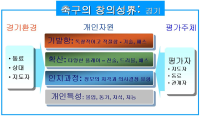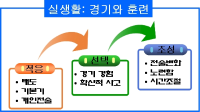Purpose The purpose of this study is to explore ‘K League Influx (KLI)’ which is the phenomenon a number of international footballers migrate to South Korea and its factors. Methods Qualitative case study was conducted with 10 footballers who have migrated to South Korea and 4 their Korean agents. Results The KLI can be explained with four factors such as (1) Asian football dream and K league as a stop (not destination); (2) Brazilian footballer salary increase caused by Chinese football policy; (3) Financial crisis of European football market; and (4) The quantitative and qualitative changes in the agent market due to FIFA’s abolition of agent system and the development of new media. Conclusions These factors are close to the properties of external factor rather than internal factor. It requires various perspectives on sport labor migration (academic significance) and new management philosophy of K league and each club (practical discussion). Therefore, this study examined the possibility of 'selling-league' and suggested the follow-up study and policy direction related to it.
Purpose The purpose of this study is to explore the trend of K league exodus and its factors. Methods Qualitative case study was conducted by selecting 9 footballers and 7 their agents as the participants who have migrated from South Korea to China and the Middle East. Results The factors of migration were categorized as three push and pull factors such as economy (individual income and club's profit), policy (employment for foreign and military service) and environment (markets in home and abroad). To understand sport migration in the economic factor, there should be the environmental condition (overseas market) to pay high salaries and transfer fee to individuals and their clubs, and at the same time, the domestic market should be relatively poor environment. In addition, this study overcame limitations of economic and environmental factors by classifying Asian quota system and military service into political factor, and found the specificity (local context) of K league. Conclusions In conclusion, this study can be regarded as the first empirical work on sport labor migration in Korea and valuable as basic data of follow-up studies.
The purpose of this study was to examine psychological capital acquisition through Asian Games Participation. 17 of national women football players were completed Psychological Capitals Questionnair. The psychological capital consists of optimism, psychological skills, self-management, collective efficacy, and performance perception was investigated after the team call-ups and before the team-release. The data was analyzed by paired t-test. As results, Korean women football players’ collective efficient and performance perception showed a statistical significance at the beginning of the team call-ups but optimism, psychological skills, and self-direction did not show statistic significances. The team-harmony, interpersonal-management, team-power, sufficient training, trust in coach, efficient communication, and psychological football factors, which were subfactor of football players’ psychological capital, showed statistical significances. However, confidence, concentration, goal-setting, imagery, willpower, anxiety-control, mental-management, life-management, training-management, innate-behavior management, physical-management, football skills, mediative skills, and football intelligence factors did not have statistic significances. These results demonstrate that effects of mega sporting events-like experiences and psychological factors’ variability and inflexibility according to weather changes should be considered when it comes to discussion of psychological factors regarding players’ performance. It is expected that this study would be a fundamental resource for understanding of psychological influences through participations in mega sporting events and discussions about further psychological interventions for teams with environmental consideration as well as methodological developments which could measure effects of the psychological interventions.

The purpose of this study was to explore a framework of understanding football performance. Researcher review was conducted to organize perspectives for football performance and drew implications as well as drift of football performance based on intelligence approach. Discussions for intelligence had been proceeded in concepts of learning ability, multiple intelligence, successful intelligence, and moral intelligence. Discussions of football performance approaches fitness, skill, and strategies in traditional intelligence aspects. The multiple intelligence perception discusses perspective, mentality, body, and analysis. The successful intelligence perspective deals with creativity, practical intelligence, and football talents. However, specific discussions for moral intelligence have not been progressed yet. FIFA’s social responsibility project and UEFA’s RESPECT campaign reflect that the discussions of football performance develops in a way of the moral intelligence. In European football, issues regarding value, such as RESPECT and against Racism, are currently emerging. Considering the change in the European football, the global football leagues will share the issues related to value in the near future. Given the fact that discussion for intelligence had been proceeded learning ability, multiple intelligence, successful intelligence, and moral intelligence, the moral intelligence will be a main concern in the further football performance discussion. The moral intelligence will be incorporated into football performance evaluations soon. Furthermore, teams and players will strive to place efforts in order for pursuing value and reputation as factors of performance.






PURPOSE This study aims to analyze the competitive advantages of Japanese and South Korean national football teams using the value, rarity, imitability, and organization (VRIO) model. Based on the results, it proposes strategies for the development of South Korean football. METHODS The research methodology is a combination of literature review, case study, and semi-structured interviews with football experts. RESULTS The Japanese football system meets all criteria of the VRIO model through its systematic youth development system, data-driven strategies, and organizational linkage between clubs and the national team, which has led to consistent performance in international tournaments. In contrast, while South Korean football possesses excellent individual player resources, it fails to fully meet the criteria of the VRIO due to a regional imbalance in the youth system, insufficient use of data, and lack of cooperation between clubs and the national team. CONCLUSIONS The interview data indicate that strengthening the youth system, adopting a data-driven approach, and improving the collaborative structure between clubs and the national team are necessary components of the development of South Korean football. This study provides specific directions for the long-term and sustainable development of South Korean football by analyzing the strategic competitiveness of national football teams in other countries using the VRIO model.
PURPOSE This study aimed to examine the mediating effect of psychological needs in the relationship between multiple coaching styles and teamwork among college football players. METHODS This cross-sectional study involved 526 elite football players. Descriptive statistics, reliability analysis, confirmatory factor analysis, correlation analysis, path analysis, and macroprocess were performed using statistical software to test the mediation effects of the data collected. RESULTS The findings suggested that autonomy-supportive and structure coaching styles positively correlated with and impacted psychological needs satisfaction and teamwork. Conversely, control and chaos coaching styles negatively correlated with and impacted psychological needs satisfaction and teamwork. In addition, autonomysupportive and structure coaching styles negatively correlated with and impacted psychological need frustration, while control and chaos styles positively correlated with and impacted psychological needs frustration. Furthermore, psychological needs satisfaction and frustration were found to partially mediate the relationships between autonomy support and teamwork, structure and teamwork, control styles and teamwork, and chaos styles and teamwork. CONCLUSIONS Autonomysupportive and structure coaching styles positively influenced teamwork by satisfying psychological needs. In contrast, control and chaos coaching styles negatively impacted teamwork by contributing to psychological needs frustration.
PURPOSE This study aims to identify how the [Goal Kicking Women] TV program has changed the perceptions of male viewers on women’s football. METHODS Using a qualitative research design, semi-structured interviews were conducted with 8 male viewers who are in their 50s. Thematic analysis was used to draw implications from the interviews. RESULTS Results show that having watched [Goal Kicking Women], 1) participants have become more familiarized with women playing football; 2) participants’ initial stereotype about women’s alleged inferiority in football has changed, as the performance of female stars in the program, who did not have any experience playing football, improved; and 3) the genuine passion that female stars showed for football made participants think that women’s football was just as good as men’s. CONCLUSIONS This study provides practical and academic implications, as it identifies men’s perceptions on women’s football and analyzes the influence of [Goal Kicking Women]. To conclude, establishing a foundation for planning and implementing effective policies to promote women’s football in South Korea is recommended.
PURPOSE The purpose of this study was to investigate the effects of perceived organizational support of high school football players on innovative performance. Of particular note, we focused on examining the mediation effect of self-management between perceived organizational support and innovative performance. METHODS A total of surveys returned was 137 and the data used for the final analysis was 130. The data was processed using SPSS 21.0 statistical program and Lisrel 9.2 for confirmatory factor analysis. RESULTS The results of the analysis were as follows: first, perceived organizational support of high school football players had a positive effect on players’ self-management. Second, players’ self-management had a positive effect on players’ innovative performance. Third, players’ self-management fully mediated between perceived organizational support and players’ innovative performance. CONCLUSIONS The study concluded that maximizing both perceived organizational support and self-management of the high school football players are necessary in order for the organization to achieve high level of innovative performance.
PURPOSE This study aims to examine the mediating effect of viewing flow on the relationship between perceived authenticity among [Kick A Goal] female viewers’ and football participation intention. METHODS A total of 414 questionnaires were distributed to [Kick A Goal] female viewers, aged from 20s to 60s, who had no experience in football. Among the collected questionnaires, the data used for the final analysis was 338 after data cleaning. The data analysis was conducted using SPSS 25.0, and it included frequency analysis, descriptive statistics analysis, correlation analysis, simple regression analysis, and a three-step mediation analysis proposed by Baron & Kenny(1986). RESULTS This study’s results were as follows: First, the perceived authenticity of female viewers positively affected viewing flow. Second, the viewing flow of female viewers positively affected their football participation intention. Third, viewing flow fully mediated the relationship between perceived authenticity and football participation intention. CONCLUSIONS In summary, this study suggests that it is significant to produce programs with authenticity and maximize viewing flow to further enhance the intention of female viewers to participate in football.
PURPOSE The purpose of this study was to understand the athletic identity of youth football players and to trace its changing trend. METHODS Participants of this study included 93 players in 2005 and 94 players in 2021, who were in middle and high schools. All participants answered open-ended questionnaires. After the results of the inductive content analysis, the changing trend of the results was assessed. RESULTS The athletic identity of youth football players were collected from 811 raw data samples collected in 2005 and 741 collected in 2021 and categorized into 19 sub-categories and 5 categories. The results show a tendency to be specific to football. The athletic identity of a football player itself is weakening, being replaced by the identity of being a student. The role of the camp is also weakening, while more privacy and autonomy are allowed to the players. As a result, efforts to secure the players’ right to study were accepted by the players, and expected to decrease as camp life with limited privacy is on the decline, and as senses toward one’s physical competence are changing. CONCLUSIONS Sociocultural contexts, including changes in the system and social modifications, are reflected in the football player's athletic identity and its changes. The athletic identity of youth football players has changed from its 2005 version of unacademic camp life with limited privacy to the 2021 version, where the player leaves camp to be provided with privacy and attend classes.